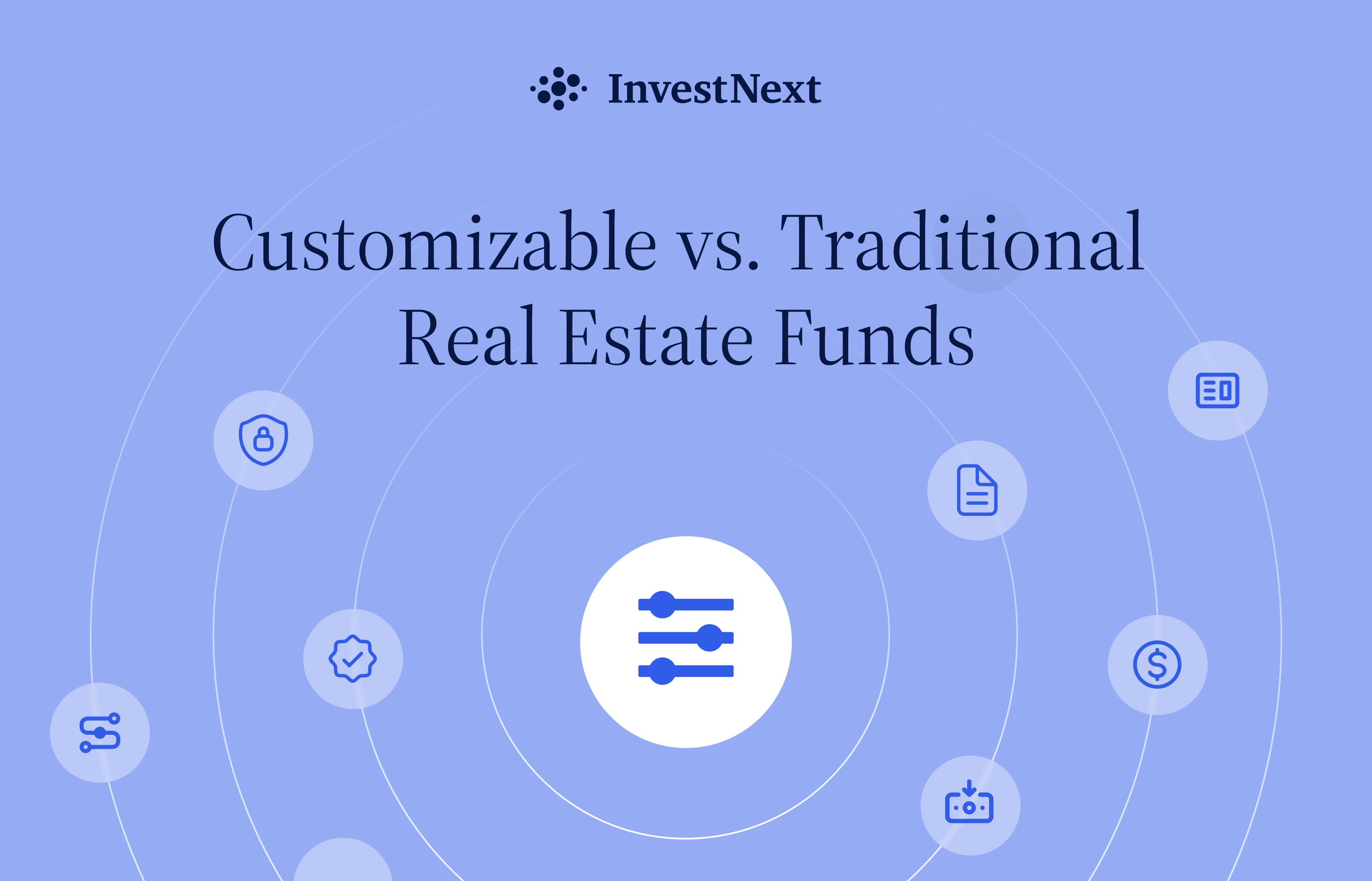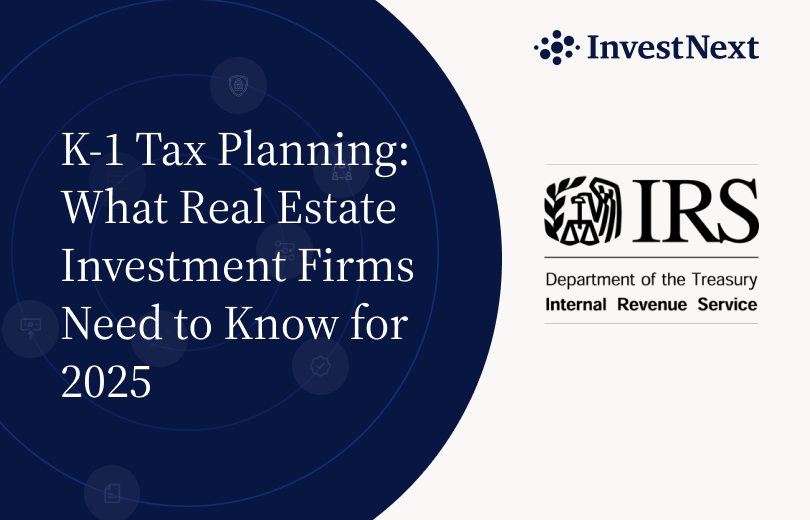At InvestNext, we’ve observed a fundamental shift in how real estate investment firms approach fund structuring. While traditional fund models once dominated the landscape, today’s managers increasingly seek flexibility in how they raise and deploy capital. Through our work with general partners across the industry, we’ve seen firsthand how customizable fund structures are transforming the way firms scale their operations and serve investor needs.
The choice between customizable and traditional fund structures impacts every aspect of a firm’s operations – from capital raising and investor management to distribution calculations and reporting requirements. This evolution in fund structuring reflects broader changes in both investor expectations and manager capabilities, driven by advances in technology and operational infrastructure.
This guide examines the key differences between customizable and traditional fund structures, helping managers understand which approach best suits their investment strategy and operational capabilities.
Understanding Customizable Funds in Real Estate
Customizable funds represent a significant advancement in real estate investment structuring, combining the efficiency of pooled investments with unprecedented flexibility in deal selection. These modern structures enable managers to maintain multiple investment strategies under a single fund umbrella while providing investors with greater control over their portfolio exposure.
The fundamental architecture of customizable funds allows managers to:
- House multiple investment strategies under unified documentation
- Add new opportunities as market conditions evolve
- Accommodate diverse investor preferences
- Build scalable investment networks
What sets these structures apart is their ability to adapt to changing market conditions and investor needs. Through our fund administration experience, we’ve seen managers successfully combine various property types and investment strategies within the same fund – from multifamily and commercial assets to specialized opportunities – all while maintaining clear reporting and efficient operations.
Understanding Customizable Funds in Real Estate
The evolution from traditional to customizable fund structures reflects broader changes in how real estate investment firms operate and scale. While traditional funds offer proven frameworks and established processes, customizable structures provide advantages that increasingly resonate with both managers and investors.
Operational Considerations
Traditional funds typically operate with:
- Fixed investment periods
- Predetermined asset allocation strategies
- Standardized investor terms
- Rigid capital calling schedules
In contrast, customizable funds enable:
- Flexible capital deployment timelines
- Dynamic investment strategies
- Personalized investor participation
- Adaptive capital management
Investment Management
The differences extend into how investments are managed and reported. Traditional funds generally follow quarterly reporting cycles with standardized distributions and limited investor interaction. Customizable structures, supported by modern investor portals, enable more frequent communication and transparent reporting.
Documentation and Compliance
Both structures require robust document management and compliance processes, but their approaches differ:
Traditional Funds:
- Single offering document covers all investments
- Uniform investor agreements
- Standard reporting templates
Customizable Funds:
- Master fund documentation with deal-specific supplements
- Flexible investor participation agreements
- Customized reporting capabilities
Key Advantages of Customizable Funds
Modern fund structures have transformed how real estate investment firms approach portfolio management and investor relationships. Through our experience, we’ve observed how customizable funds particularly excel in addressing traditional pain points while creating new opportunities for growth.
Enhanced Portfolio Control
Customizable funds enable managers to maintain multiple investment strategies while giving investors unprecedented control over their exposure. This flexibility manifests in several key ways:
- Strategic Diversification: Managers can offer various property types and risk profiles under one fund umbrella
- Targeted Participation: Investors can align specific investments with their portfolio goals
- Dynamic Capital Deployment: Ability to launch new opportunities as market conditions evolve
- Efficient Resource Allocation: Streamlined fund administration across multiple investments
Operational Efficiency
Modern investment management platforms have transformed how customizable funds operate, enabling:
- Unified investor management across multiple investments
- Automated waterfall calculations for complex distributions
- Integrated reporting and communication systems
- Streamlined capital event processing
Investor Experience
Through sophisticated investor portals, customizable funds offer enhanced transparency and control:
- Real-time access to investment performance
- Deal-specific reporting and documentation
- Simplified investment processes
- Clear communication channels
Considerations and Implementation Challenges
While customizable funds offer significant advantages, successful implementation requires careful attention to several key areas.
Operational Infrastructure
Managing customizable funds demands robust systems and processes:
- Comprehensive document management for multiple investment structures
- Sophisticated investor relations capabilities
- Integrated financial reporting systems
- Scalable administration processes
Success hinges on having the right operational foundation in place before launching more complex fund structures.
Investment Strategy Alignment
Managers must ensure their customizable fund structure aligns with:
- Core investment thesis
- Target investor preferences
- Market opportunity set
- Operational capabilities
Compliance Framework
Maintaining compliance across multiple investment structures requires:
- Robust investor verification processes
- Clear documentation trails
- Regular reporting protocols
- Comprehensive audit capabilities
Investor education requirements
Fund managers must allocate their most important resources to teach investors about the unique features of customizable funds. They need to explain complex investment structures clearly and discuss risk factors and potential returns. The task becomes more challenging with sophisticated investment vehicles that combine multiple asset classes or investment strategies.
Risk management strategies
Fund managers need a comprehensive approach to handling market-related and operational risks. They must set up resilient systems to track property performance, market conditions, and regulatory changes. Technology integration is vital to reducing risk. It enables live monitoring and automated compliance checks.
Setting up professional processes becomes especially important when you have funds that grow their operations. Professional fund administration services help managers overcome these challenges by providing:
- Expert accounting and bookkeeping services
- Automated distribution calculations
- Simplified tax document preparation
- Multi-entity consolidation capabilities
Modern investment platforms have evolved to handle these complexities. They provide integrated solutions that combine fund administration, investor relations, and compliance management. These technological advances help fund managers excel operationally while they focus on core investment strategies and portfolio management.
Conclusion
The choice between traditional and customizable fund structures represents more than just a technical decision – it reflects a fundamental approach to how real estate investment firms grow and serve their investors.
InvestNext’s platform empowers you to build customizable funds your way while creating a seamless experience for your investors.
Our essential tools and integrated solutions support unlimited investment classes per project, custom distribution plans for operating cash flow and capital events, pro-rata distribution hurdles for time-weighted allocation, and distribution reinvestment.
The platform automatically maintains proper ownership calculations and seamlessly updates market values while preserving existing investor positions—all through a unified investor portal experience.
Want to learn more about building scalable fund structures? Schedule a demo to explore how technology is transforming real estate investment management.








